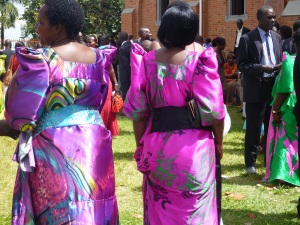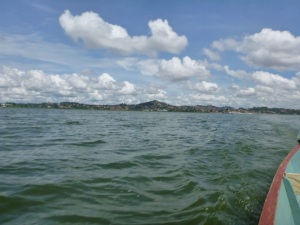We are just back from another weekend in Kampala, some six hours away from Gulu by coach. It is a city I grow fonder of on each visit. Apart from a visit to Namirembe Cathedral,
ten weddings
going on in one day.
We found this time that you can go from the inner city down the Ggaba road to Ggaba (the port)
and be across Lake Victoria
to deep countryside within about half an hour.
We are, as you can see, well into the rainy season.
I have also been reading Rysyard Kapuscinski on Africa (‘The Shadow of the Sun, My African Life’, publ. Penguin Books, 2001). He describes visiting Uganda during Amin’s time, round about 1978:
“One day I was wandering around the market in Kampala, it was somewhat empty, many stalls were broken, abandoned. Amin had stripped and ruined the country. There was no traffic in the streets and the shops, which Amin had earlier confiscated from their Indian owners, gaped with musty emptiness or were simply boarded up with wooden planks, plywood or sheets of tin”
(‘The Shadow of the Sun, My African Life’, publ. Penguin Books, 2001; page 145)
It is not like that now.
Kapuscinski also demonstrates how much Amin, like Obote, or Museveni or more pertinently to us in the North, Kony, was a product of political circumstances. Colonialism and independence gave us Amin, he came through the Kings African Rifles in a familiar pattern since Lugard in the 19th Century.

A poor copy of Lugard’s 19th century Fort, in front of the 20th century mosque started by Amin and paid for by Gadaffi
As Kapuscinski writes Amin was one of:
“mercenaries recruited from the tribes hostile towards the population on whose territory they were to be garrisoned” (page 139)
Amin was a Kakwa from way up in the North West, colonial army officers promoted the strongest, most obedient, least bright amongst their Africa troops. The colonials wanted to keep power, “to prove that they were irreplaceable”. Amin, eventually Commander of the Army was a classic example of this process. Milton Obote, the first Ugandan Prime Minister, was a Lango, closely related to the Acholi, ie from the North of the Nile. Acholi and Langi despised the Kakwa.
When Obote accused his violent and unpredictable army commander of theft, you can see where this would end up. On taking power Amin purged the Army, his power base, of troops from the North. The consequences of this, and the disbanded troops of later dictators would cause huge reverberations, violent demands for Northern independence and the rise of fanatics like Joseph Kony and the LRA.
The divisions between North and South are still very strong, when we tell Kampalans that we live in Gulu, they always ask: “What is it like up there” and say that one day they hope to go there. A statement made in the same way a Briton will say: I have always wanted to go to…The Faroe Islands, or Greenland , or somewhere remote, a bit mythical of which you know very little; it is a journey of course that you will never make.













2 comments
Comments feed for this article
May 6, 2013 at 8:47 am
Ken
I enjoyed reading your web site. I know Gulu and Kampala well, having visited both about six times in the last three years. In fact, we’re due to come back to Gulu in about three weeks from now. I am a white Briton and my partner is an Acholi woman living in the UK. I can’t wait to go there again as the people are so friendly and I really enjoy the place.
LikeLike
May 6, 2013 at 9:22 am
Mark White
Dear Ken,
good to hear from you, do say hello when you come back to Gulu. The thunder clouds and rain are really building up now so bring an umbrella.
Mark
LikeLike